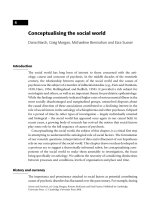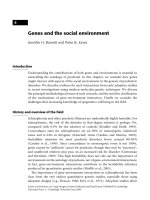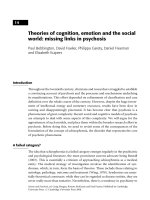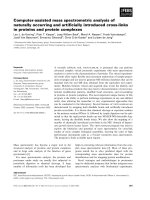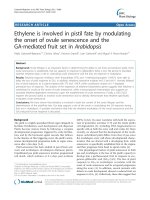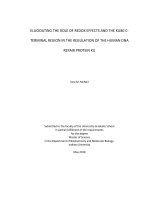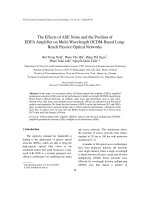Theories of cognition, emotion and the social world - missing links in psychosis
Bạn đang xem bản rút gọn của tài liệu. Xem và tải ngay bản đầy đủ của tài liệu tại đây (149.16 KB, 19 trang )
14
Theories of cognition, emotion and the social
world: missing links in psychosis
Paul Bebbington, David Fowler, Philippa Garety, Daniel Freeman
and Elizabeth Kuipers
Introduction
Throughout the twentieth century, clinicians and researchers struggled to establish
a convincing account of psychosis and the processes and mechanisms underlying
its manifestations. This effort depended on refinements of classification and case
definition over the whole course of the century. However, despite the huge investment of intellectual energy and monetary resources, results have been slow in
coming and disappointingly piecemeal. It has become clear that psychosis is a
phenomenon of great complexity. Recent social and cognitive models of psychosis
are attempts to deal with some aspects of this complexity. We will argue for the
appositeness of such models, and place them within the broader research effort in
psychosis. Before doing this, we need to revisit some of the consequences of the
formulation of the concept of schizophrenia, the disorder that represents the core
of psychotic phenomena.
A failed category?
The idea that schizophrenia is a failed category emerges regularly in the psychiatric
and psychological literature, the most prominent current advocate being Bentall
(2003). This is essentially a criticism of approaching schizophrenia as a medical
entity. The medical strategy of investigation involves the identification of syndromes, which, in turn, form the basis of theories. These include those relating to
aetiology, pathology, outcome and treatment (Wing, 1978). Syndromes are essentially theoretical constructs: while they can be regarded as disease entities, they are
never really more than tentative. Nevertheless, there is a tendency in psychiatry to
Society and Psychosis, ed. Craig Morgan, Kwame McKenzie and Paul Fearon. Published by Cambridge
University Press. # Cambridge University Press 2008.
220
P. Bebbington, D. Fowler, P. Garety et al.
regard psychiatric syndromes as having more virtue than they actually possess.
They do, however, form a useful basis for research. If theories about syndromes are
refuted, consideration may be given to abandoning them. In medicine we generally
reject theories, of aetiology and so on, before rejecting the theoretical construct
represented by the syndrome. We may nevertheless eventually decide that the
syndrome has failed, in the sense that the knowledge built up in relation to it is
confused and imprecise, and there may be better ways of organising the clinical
information for the purposes of research. There is current debate about whether
we have reached this stage with schizophrenia.
One of the difficulties for a biomedical approach in psychiatry is the sheer
cussedness of the subject matter. It is, for example, extremely difficult to construct
a classification, as categories in psychiatry are notorious for overlapping one
another. This is not merely a problem of imprecise definition: the subject matter
is actually hierarchical rather than planar, and any attempt to construct a flat
classification is thus probably doomed to failure.
The nature of psychiatric phenomena creates three crucial problems for the
definition of categories like schizophrenia. The first is the threshold problem, that
is, the point at which the syndrome becomes recognisable and distinguishable
from normal experience. The second is the boundary problem, the difficulty of
drawing valid lines between, for example, schizophrenia and bipolar disorder.
Added to this is a third problem, which is both empirical and conceptual. This is
that the disorder seems to be inherently difficult to explain.
One of the early authorities to grasp the problem of the threshold was Jaspers
(1913). He saw schizophrenia as the battleground between opposing traditions of
explanation in science. The methods of the physical sciences were concerned with
causal explanation, whereas social sciences involved appreciation through a process of understanding, through meaningful connections. His view was that where
understanding failed (as it seems to in people’s attempts to share the experiences
of those deemed to be mad), we are left only with resort to physical explanation.
The implication is that in such circumstances we are facing a physical illness
with physical causes. The conclusion is that there ceases to be room for explanations of the schizophrenic experience in terms of social contexts, and that
cognitive accounts represent understanding at a different level from biological
explanations. The resulting biological hegemony held sway in psychiatry until the
last decades of the twentieth century, and is only now being replaced by a more
flexible and comprehensive approach to the problems besetting scientific research
in schizophrenia.
Jaspers himself never regarded schizophrenia as a no-go area for social and
psychological research. He was quite happy with the idea that psychosis could be
meaningfully connected to circumstances, although reluctant to see the process
221
Cognition, emotion and the social world
as wholly understandable. He did acknowledge that it was difficult to identify the
point at which paranoia became delusional, and there is now considerable evidence confirming his view.
Psychosis as a continuum with normal experience
Modern cognitive models of psychosis actually start by postulating continuities
between psychosis and normal experience. The emergence of psychotic phenomena thus reflects an abnormal concatenation of largely normal mechanisms. What
is weakness in the medical category, in this theoretical formulation becomes
strength. In the past, the urge to make a categorical distinction between psychosis
and normality almost certainly led to a Procrustean tendency to discount unusual
beliefs and experiences in people we would be reluctant to see as undergoing a
psychosis. However, it became apparent by the late 1980s that paranoid ideation
and anomalous experiences, such as hearing voices, were not confined to clinical
groups. It is clear that the frequency of auditory hallucinosis greatly exceeds the
accepted prevalence of psychosis (e.g., Wiles et al., 2006). The distinguishing
feature of those in contact with services is the level of distress occasioned by their
unusual experiences (Hanssen et al., 2003; van Os et al., 1999).
The distribution of unusual beliefs in the populace is also extensive. Many
people are convinced of the truth of ideas that are not supported by available
and accessible evidence. These include beliefs in astrology, alien beings, telepathy
or ghosts. Political beliefs are held with strong conviction even though they may be
untried, or indeed tried and found wanting. People who hold these cherished ideas
typically have a confirmatory bias, being unlikely to consider alternatives impartially. These beliefs shade into what would be regarded as delusional, since the
thinking that underpins them is similar in style to that in people with acknowledged psychosis.
Attempts have been made to define delusions in terms that would enable them
to be distinguished clearly and reliably from normal thinking. The form of words
varies, but generally implies the following: they are held with a basic and compelling subjective conviction; they are not susceptible to contrary experience or to
counter-argument; they are impossible, incredible or false; they lie outside the
belief systems characteristic of the individual’s cultural group. However, because
of the overlap with ‘normal’ thinking, it has been impossible to construct criteria
that are, individually or jointly, both necessary and sufficient for an operationalised definition (Bebbington and Broome, 2004).
The continua of beliefs in the community have been demonstrated empirically.
One example concerns ‘paranoid’ beliefs, in other words, those relating to selfreference and threat. Freeman et al. (2005b) found that 30% of an internet sample
222
P. Bebbington, D. Fowler, P. Garety et al.
30
y = 24.474e–0.2569x
R2 = 0.9286
Proportion of population (%)
25
20
15
10
5
0
0
5
10
Total number of paranoia ideas
15
20
Figure 14.1 Distribution of paranoia scores in a student population (taken with permission from Freeman
et al., 2005b)
of students had such ideas. Moreover, the frequency distribution of individual
paranoid ideas followed an exponential curve (Figure 14.1), with the relationship
between them being non-hierarchical, such that more extreme ideas were predictive of those that were less extreme but not vice versa. This finding has now
been corroborated using general population data (Bebbington, P. E. et al. The
paranoia dimension in the general population (submitted to the British Journal of
Psychiatry)). The pattern is much like that shown by affective symptoms (Melzer
et al., 2002; Sturt, 1981). At a single point in time the continuum is defined by
differences between individuals, who are thus located at individual positions on
the curve. However, people are themselves likely to vary in a way that would place
them at different positions on the curve at different times, dependent on changing
circumstances. In a sense, they would move along the curve.
These findings have considerable relevance to the aetiology of psychosis. They
imply that in some people movement along a continuum (indeed probably more
than one continuum) results in the emergence of psychosis. Thus the role of
aetiology is to explain exactly why particular people make this journey at particular
times in their lives. In the genetic arena, this suggests a focus on quantitative
analyses (Linney et al., 2003), along with the identification of quantitative trait loci
(Plomin et al., 1994). In the psychological domain, it implies the concatenation of
different psychological attributes, some cognitive, some emotional (Hanssen et al.,
223
Cognition, emotion and the social world
2005; Krabbendam and van Os, 2005; Krabbendam et al., 2005). There are also
implications for treatment, in particular psychological treatments, such as cognitive behaviour therapy (Kuipers et al., 2006).
The boundary problem
The boundary problem, whereby schizophrenia is imprecisely separated from
other psychiatric conditions, has also been a source of discomfiture. The relationship between bipolar disorder and schizophrenia, for instance, is certainly ambiguous. Clearly some individuals have mood dysregulation, and some have psychotic
experiences. However, many have both, and in varying proportions. While
attempts may be made to see affective psychosis and non-affective psychosis as
distinct, they really represent opposite ends of a spectrum, and this is reflected in
considerable overlap in the candidate genes associated with the two conditions
(Craddock and Owen, 2005; Craddock et al., 2005; 2006).
Mood disturbances of some kind are almost invariable in cases of schizophrenia.
Thus, up to 40% of people with schizophrenia also have clinical levels of depression (Birchwood, 2003; Sands and Harrow, 1999), 30% meet criteria for posttraumatic stress disorder (Mueser et al., 1998), 20% have panic disorder (Turnbull
and Bebbington, 2001) and up to 25%, obsessive compulsive disorder (Berman
et al., 1995). For a classification seeking to distinguish affective and non-affective
forms of psychosis, this is an embarrassment. However, once we cease to worry
about the overlap and think of emotional changes as potentially an integral part of
the psychotic process, it becomes possible to see it as a doorway to explanation.
This is easy for cognitive models of psychosis, which all involve an acknowledged
role for affect (Birchwood, 2003; Garety et al., 2001).
Aetiological processes
What then of the problems of explaining schizophrenia in biomedical terms? We
define schizophrenia in relation to people’s reports of their unusual mental
experiences. It would make life much simpler if we had privileged access to some
underlying condition or entity. However, all we have to go on is the disorder as
defined, the phenomena, not the noumena. In other words, it is the strange beliefs,
the hallucinations, and their contents, that we have to explain.
There has long been a prima facie assumption about aetiological theories in
psychosis, a reductionist position placing genetic explanations at the beginning of
the aetiological process. Virtually all genetic research in schizophrenia has been
based on the assumption that genetic abnormalities lead to abnormalities in
protein function, with consequent distortions of enzymatic activity, and that
224
P. Bebbington, D. Fowler, P. Garety et al.
these in turn lead to corresponding deficits in neuronal function. These deficits
then result in cognitive dysfunctions that form the substrate for the schizophrenic
experiences that permit the diagnosis of the disorder. This is obviously a very
useful working paradigm, but it must be treated with caution.
The high heritability of schizophrenia is easy to demonstrate from twin studies
(Craddock et al., 2005). However, recent research has served to emphasise that not
only is schizophrenia a complex disorder to the clinical observer, it is also complex
in genetic terms. Such disorders have relatively high population prevalence, are
non-Mendelian and are imprecisely distinguished from the normal range. The
search for genes linked to schizophrenia has been long, arduous and expensive
(Norton et al., 2006; Owen et al., 2005). Candidates have been unearthed, but their
association with schizophrenia remains tentative. The genes encoding dysbindin
(DTNBP1) and neuroregulin (NRG1) are the strongest contenders, with evidence
for other genes (disrupted in schizophrenia (DISC1), D-aminoacid oxidase activator
(DAOA), regulator of G-protein signalling 4 (RGS4) and V-AKT murine thymoma
viral oncogene homolog 1 (AKT1)) being at least suggestive (Norton et al., 2006).
Some have been associated with abnormalities of brain structure and enzyme
function, which, albeit plausible, would seem to have a tenuous connection to
the schizophrenic phenotype (Callicott et al., 2005; Harrison and Weinberger,
2005; Meyer-Lindenberg et al., 2005). Given the modern synthesis of evolutionary
theory, genetics and developmental biology, focusing solely on encoding for
enzymes is likely to prove simplistic, even though links with schizophrenia may
be found. After all, only two percent or so of the DNA in human cells produce
proteins that act as enzymes, while much more is involved in complex regulatory
systems that switch the functions of protein-encoding genes on and off, something
clearly of potential relevance to an acknowledged developmental disorder like
schizophrenia. These issues have at last started to inform genetic research in
schizophrenia (Glaser et al., 2006; Law et al., 2006; Lipska et al., 2006).
Adjacent elements in the aetiological process seem likely to fall far short of a
one-to-one relationship, with the implication that at every step on the way the
specificity of relationships is progressively lost. The consequence is that the
association of individual genes with schizophrenia must inevitably be attenuated,
with small effect sizes (Norton et al., 2006).
Moreover, the genes identified so far seem to be associated with neurocognitive
deficits (Hariri et al., 2003; Meyer-Lindenberg et al., 2005). These are plausible
antecedents of negative symptoms of schizophrenia, and there is appreciable
empirical support for the association between them (Pinkham et al., 2003). Thus
genetic explanations so far lean towards an explanation of negative symptoms.
However, the heritability of schizophrenia is the heritability of positive symptoms,
since it is from these that the condition is identified. The potential association of
225
Cognition, emotion and the social world
the Val/Val allelic form of COMT with vulnerability to psychotic responses to
cannabis might be one way round this difficulty (Caspi et al., 2005). However, we
fall far short of a comprehensive explanation in genetic terms for the positive
symptoms responsible for the heritability of the condition in the first place.
There are further problems with the aetiological process. The implicit unidirectionality is an act of faith that almost certainly cannot be sustained. Thus the way
in which heritability is calculated means that it actually includes gene–environment
interaction. Moreover, gene–environment interaction covers environmental gene
induction, and the inducing environment may be social as well as physical. Thus,
natural variation in the competency of mouse mothers affects their offspring’s
responses to stress in later life (Meaney, 2001), apparently mediated by epigenetic
changes involving histone regulation of DNA expression. This is then maintained,
and affects the offspring’s own parenting behaviour (Fish et al., 2004; Weaver
et al., 2004). Thus the causal direction may sometimes run from the social to the
physical, rather than the other way around. Furthermore, our knowledge about
putative aetiological factors is based on induction. Thus, because some people with
schizophrenia have, for example, a family history of the same condition, an
inductive leap is made to the conclusion that all schizophrenia has a genetic
basis. The frailty of the logic underpinning this inference is apparent. As the same
caveat applies to social theories, aetiological modesty is imperative on all sides.
The final problem relates to the nature of schizophrenic symptoms themselves.
Most of the experiences that form the basis of the identified symptoms of schizophrenia are about something: they carry within them representations of the social
world (paranoid ideation is an obvious example of this). This is the characteristic
of intentionality identified by Brentano (1874). Defining a medical condition in
terms of experiences that have intentionality means that explanations in purely
physical terms will always be incomplete.
This is the context in which models of psychosis involving social, emotional and
cognitive elements have been developed. They do not deny an important role for the
physical matrix of disorder, but they do add to the complexity and probably to the
potential of explanation. They form one part of the overall model. There are several
variants, and all are better described as social-cognitive-emotional models. They
focus on the sorts of explanation that can be developed for considering the person
with psychosis as an agent in a social and societal context. They also seek to explain
psychosis by trying to explain single symptoms or coherent groups of symptoms.
Analysing single symptoms
The study of single psychotic symptoms, or single types of symptom, is assisted by
a clear account of the symptoms themselves. Thus cognitive models encourage a
226
P. Bebbington, D. Fowler, P. Garety et al.
return to the precision of the early psychopathologists. However, descriptions are
amplified by attempts to discern processes that may underlie the mental experiences corresponding to the symptoms. This activity should be distinguished from
actual explanation – it is more akin to exegesis, and increases the potential targets
for explanation. An example of exegesis is provided by Frith in his persuasive
account of passivity experiences as a combination of ‘forward memory’ and an
exaggerated sense of agency (‘if it is not me, it must be someone else’) (Frith, 2005).
Phenomenological analyses may also clarify linkages between symptoms conventionally regarded as separate. For example, there are relationships between thought
insertion, loud thoughts and thought broadcast. The essence of thought insertion is
not the idea of external origin, but the loss of the sense of possession of the mental
experience. This is shared by other passivity experiences, but also by auditory
hallucinations. Loud thoughts are thoughts acknowledged by the person experiencing them, but they have the quality of loudness shared by our experience of sound
waves. In this, they of course resemble auditory hallucinosis. Thought broadcast has
been described imprecisely, but close attention to the self-reports of those who suffer
from it reveals that the essential feature is the experience of thoughts that are
externally projected. Such thoughts share this feature with some but not all forms
of auditory hallucinosis. Thus these four types of symptoms exhibit variously the loss
of the sense of possession, loudness and external projection, and the exact pattern of
these three features determines what symptoms may be identified.
Projection and loudness merit further comment, as both can be seen as distortions of normal processes. It is probably of enormous evolutionary advantage to
integrate the brain changes initiated by the immediate environment into an
externally projected world. This capacity for projection is self-evidently inherent
in human beings, and the external projection that characterises hallucination,
thought broadcast and passivity experiences is thus also a failure of a normal
mechanism. Loudness is the mental experience normally attached to the brain
events corresponding to the impact of sound waves on the cochlea. As such, it flags
up these events as relating to the external world. When the flag becomes attached
to other mental experiences, they become anomalous (as in loud thoughts).
Loudness and external projection may have a very similar neural embodiment,
but their separation in particular psychotic symptoms suggests they are distinct.
A further example of this kind of analysis concerns the issue of meaning. This can
be interpreted as an emotional component of mental experience. In psychiatric
disorder, levels of meaning can be either increased or reduced, or both. The most
obvious example of this reregulation occurs in depression and mania. People with
depression lose a sense of meaning, just as those with mania acquire it. Perception
carries an emotional charge that becomes apparent when it is lost. Loss of meaning
underlies experiences such as dulled perception, depersonalisation and derealisation,
227
Cognition, emotion and the social world
while in mania heightened perception affects the perceived intensity of colours and
sounds and the beauty of music. However, meaning also attaches to non-perceptual
mental experiences. In depression, this includes lost emotions: a painful sense of
knowing and remembering the emotion but no longer being able to feel it. In general,
reduction in the emotional component of mental experiences is negative if not always
painful, while increases are more ambiguous. Thus, the increased signification
attached to paranoid ideas is distressing while that attached to heightened perception
and to some forms of ideas of reference may be pleasurable. Capgras’ syndrome is a
form of delusional depersonalisation, whereby the loss of the emotional component
of person recognition results in delusional ideas concerning the replacement of
known people by unknown impostors. In contrast, the Fregoli syndrome is associated
with an increased signification of person perception, resulting in the belief that
strangers are actually friends and relatives in disguise. It is also possible to conceive
of mental experiences involving loss of the sense of possession as being downregulations of the emotional significance of the experience.
There is, thus, a prima facie argument for suggesting that change in the emotional components of mental experience underlies many psychiatric symptoms
including those involved in psychosis. This would again imply continuities
between symptoms regarded as psychotic and those that are not. It remains
possible, of course, that this proposition arises from over-interpretation and that
there is no underlying commonality of the type described.
The distinctiveness of symptoms probably implies that there are also distinctions
between the processes that generate them. Thus disorders like Fregoli and Capgras
may include a specific malfunction of the part of the fusiform gyrus concerned with
facial recognition (Pinkham et al., 2005). Nevertheless, the possibility of a common
contribution has been acknowledged by Kapur (2003) in his proposition that
dopamine dysfunction in psychosis often increases salience but sometimes reduces it.
Cognitive models of psychosis
Over the last 10 years or so, several cognitive models of psychosis have been
proposed (e.g., Bentall et al., 2001; Birchwood, 2003; Broome et al., 2005;
Fowler, 2000; Freeman et al., 2002; Garety et al., 2001; Morrison, 2001). They
seek to identify the origins of psychosis by explaining the causation of individual
symptoms. To do this, they adduce interactions between social contexts, emotional tone and cognitive processing. They vary in the emphasis laid on these
components and the extent to which the involved processes are regarded as
unusual concatenations of normal internal and external circumstances.
Our own model emphasises the continuity of psychotic and non-psychotic
experiences; a central role of appraisal; the role of low self-esteem and emotional
228
P. Bebbington, D. Fowler, P. Garety et al.
changes; and findings relating to adverse social environments. While we do not
specify biological explanations in the model, they are implicit. In other words,
some of the components may be related to abnormal neural function. The model
emphasises, as one route to symptom development, the significance of cognitive
dysfunction leading to anomalous experiences, and the appraisal of these experiences as externally caused. Unlike Morrison (2001), we think this distinguishes
psychosis from common mental disorders, such as anxiety and depression. Virtual
reality experiments with normal subjects are of interest here. Some normal subjects develop persecutory thoughts even in neutral scenarios. Crucially, it seems
that previous anomalous experiences of a schizotypal variety differentiate between
people who are merely anxious in the situation and those who develop persecutory
ideas (Freeman et al., 2003, 2005a).
A considerable amount of recent work has tested hypotheses derived from these
cognitive models. We ourselves start from the common assumption that people who
develop a psychotic illness do so on the basis of a predisposition of biological or social
origin that renders them vulnerable to stress. This vulnerability is expressed in
emotional and cognitive changes that contribute to anomalies of conscious experience, of which the most salient example is auditory hallucinosis. Anomalous experiences seem likely to be embodied in information processing disturbances (Frith,
1992; Gray et al., 1991; Hemsley, 1993, 2005). These authors have suggested that
anomalous experiences are intrusions into conscious awareness arising from defects
in the continuous integration of current experience with stored memories. However,
the mere experience of anomalies does not lead to overt psychosis without an
interpretation that lends them personal significance and attributes to them an
external origin. Such interpretation is shaped by information processing biases,
pre-existing schematic beliefs about the self and others, and emotional disturbance,
all of which interact with (and sometimes originate from) the social contexts that
individuals find themselves in. We will consider these elements in further detail.
Social influences on psychosis
Psychosocial factors are comprehended in a variety of ways. Research into the
relationship between life events and various psychiatric conditions has been a
major thrust in psychiatry over the past 40 years. Life events obviously range
from the catastrophic to the relatively banal, and events of all types have been
studied in relation to schizophrenia. Initial investigations involved recent events
with significant social connotations (Bebbington et al., 1996). More recent
research has examined the ebb and flow of daily hassles (see Chapter 9).
Other research has involved quite complex aspects of the person’s environment,
for example, the immediate family environment (see Chapter 8) and social
229
Cognition, emotion and the social world
networks. Yet other studies focus on the wider context in which individuals are
located. Examples are the overall experiences of people seeking asylum, migrating
for other reasons to a new region or country (Cantor-Graae and Selten, 2005;
McGrath, 2006), or forming part of an ethnic or cultural minority (Fearon et al.,
2006) (see Chapter 10). In the past 10 years or so there has been increasing interest
in more distant social contexts. Some epidemiological studies have examined the
impact of urban upbringing and changes of schooling (both are associated with
later psychosis) (see Chapter 6). A number of research groups have examined the
impact of traumatic events, in particular child sexual abuse (Bebbington et al.,
2004; Mueser et al., 1998; Read et al., 2005) (see Chapter 7). This has been
accompanied by a convergence of ideas about post-traumatic stress disorder and
psychotic experience (Fowler et al., 2006). These new areas of research have raised
questions about how early psychosocial experience might link with the later
manifestation of psychosis.
Stressful events and psychosis
The study of life events occurring immediately before the onset or relapse of
psychosis dates from the 1960s (Bebbington et al., 1995). Even in nuclear schizophrenia, many cases experience stressful and personally significant events in the
few weeks or months before an episode. The association of recent stressful life
events with relapse into positive symptoms is well established (Bebbington et al.,
1995; Nuechterlein et al., 1994). A role for events before first episodes would
suggest an effect going beyond the mere triggering of subsequent episodes in
people who had already manifested the disorder, presumably for other reasons.
While the evidence for events in relation to first episodes is still thin, it has recently
been bolstered by an indication of specificity: the strength of the association is
increased when the event has attributes that can be meaningfully associated with
the content of psychosis. Thus, events characterised by intrusiveness seem to be
especially linked to psychosis, and perhaps to paranoid ideation in particular
(Harris, 1987; Raune et al., 2006).
Distant trauma and psychosis
Until recently it was assumed that the impact of events would dissipate fairly
rapidly, and this is almost certainly true for most sorts of event, as they quite clearly
cluster in the vicinity of onset (Day et al., 1987). However, recent studies have also
made clear that a history of trauma and victimisation is very common in people
with psychosis. Although these may both precede and accompany episodes of
psychotic disorder (Mueser et al., 1998), many have occurred long before onset,
230
P. Bebbington, D. Fowler, P. Garety et al.
raising the possibility that they may have produced a longstanding vulnerability
that has been translated later into a psychotic episode. These findings have been
incorporated into current psychosocial models of psychosis (Garety et al., 2001;
Kuipers et al., 2006), which also postulate that stressful events may contribute to
the initial emergence of psychosis. The obvious mechanism is that they change
persistent psychological styles and attributes, but they may also increase biological
sensitivity to stress. Bullying and sexual abuse are particularly associated with
negative self and other schemas, and with positive symptoms such as persecutory
delusions and hallucinations. Such experiences lead to a psychosis particularly
characterised by hallucinations, although direct links between trauma and hallucinatory content seemed to be relatively rare (Hardy et al., 2005).
Recent research into cognitive processes
Recent research has confirmed the importance of reasoning biases in psychosis.
However, such reasoning biases are common: people often hold with conviction
ideas without much basis in fact, and it is normal for them not to consider
alternatives impartially. This is the so-called confirmatory bias. People with
psychoses show all these features of normal thinking. It has been found that they
also tend to use less evidence before making a decision: the jumping to conclusions
(JTC) reasoning bias (Garety and Hemsley, 1994). This has particular relevance for
delusional thinking. Interestingly, JTC persists after recovery from delusions
(Peters and Garety, 2005). Moreover, it appears to be related to belief inflexibility
and an inability to generate alternative explanations for experiences (Freeman
et al., 2004). The JTC reasoning bias is thus a good candidate for a true trait
vulnerability for psychosis. Not surprisingly, reasoning biases appear to make a
specific contribution to the level of conviction with which delusions are held
(Garety et al., 2005).
Attributional biases may also contribute to psychosis, although here the
evidence is inconclusive (Bentall and Kinderman, 1999; Jolley et al., 2006).
Externalising biases may be particularly characteristic of people with persecutory
delusions, whereby they attribute blame for negative events to external factors,
predominantly to other people. This is markedly different from the self-blame
of people with depression. Extreme negative evaluations of the self and others
mediate the link between emotional processes and positive symptoms of psychosis
(Fowler et al., 2006; Smith et al., 2006). Low self-esteem in people with psychosis is
often associated with criticism from carers (Barrowclough et al., 2003).
There is other evidence linking negative affect and positive symptoms, both from
prospective studies and from research using time-sampling. Thus, Krabbendam
and her colleagues (2005) demonstrated that depression encourages the later
231
Cognition, emotion and the social world
development of delusions in people with pre-existing anomalies of experience,
while Myin-Germeys et al. (2001) found that fluctuations in positive symptoms
of psychosis were associated with time-sampled changes in negative affect.
People with psychosis also have well established cognitive deficits in attention
and working memory, which may also contribute to symptom formation (Joyce,
2005), although the precise mechanism remains unclear. Hallucinations or passivity experiences may be specifically related to self-monitoring, another cognitive
process (Blakemore et al., 2003; Frith, 1992; Johns et al., 2001). In this context,
Hemsley has provided evidence for a disruption to a sense of self (Hemsley, 1998,
2005). The ability to process immediate experience may be disrupted by a poor use
of contextual information (Barch et al., 2004).
Appraisal is central
Depressed mood in people with psychosis is related to attributions of power and
control to the people persecuting them or responsible for their hallucinations
(Birchwood, 2003; Green et al., 2006). Negative appraisals of symptoms, of self and
of others are of great clinical importance because they relate to suicidal ideation
and high alcohol intake (Fialko et al., 2006). The appraisal of danger by people
with psychosis leads to safety behaviours, which are important in the maintenance
of delusions (Freeman et al., 2003, 2007; Morrison, 2001). People with psychosis
also appraise the consequences of their illness, just as anyone with a physical
illness does (Lobban et al., 2004). Unsurprisingly, these appraisals are likely to
be negative, and thus associated with distress (Watson et al., 2006). Moreover,
disagreements between carers and patients about appraisals of the illness seem
to be associated with negative affect in both (Kuipers et al., 2007).
Stress and cognition
Many people with psychosis have experienced significant psychosocial trauma in the
past, and many are troubled by memories of it (Bebbington et al., 2004; Janssen et al.,
2004; Johns et al., 2004; Krabbendam et al., 2004; Mueser et al., 1998; Read et al.,
2005). While links are now reasonably well established between trauma and psychosis, we must explain how those links might work. The original conceptualisation of
post-traumatic stress disorder was that it required no further explanation: every
person exposed to catastrophic and life-threatening stress would respond with a set
of symptoms that were largely affective, but included the specific and interlinked
experiences of re-enaction and avoidance. It is now apparent that the relationship
between life-threatening stress and the features of PTSD is not guaranteed
(Rechtman, 2004). Thus PTSD itself requires additional explanation, and a
232
P. Bebbington, D. Fowler, P. Garety et al.
relationship between catastrophic stress and the emergence of psychosis certainly
does. Why is it that in processing such stress a minority of people (and only a
minority) develop psychosis? Is there any kind of meaningful link between the nature
of the events and the form and content of psychosis? Are there particular attributes of
events that encourage psychotic reactions, and is this effect enhanced by the psychological or indeed neurobiological attributes of the person experiencing them?
Post-traumatic stress disorder is of special interest because the re-experiencing
phenomenon shares with psychotic experience the quality of intrusiveness, and yet
is different. Is it possible that the intrusive phenomena of PTSD lend themselves to
transmutation into the alien intrusive experiences of psychosis? If so, how does this
happen? A special variant of cognitive models of psychosis seeks to explain this: the
so-called catastrophic interaction thesis (Fowler et al., 2006).
Fowler et al. (2006) propose four separate pathways between severe stress and
psychosis. The first involves a direct link between intrusive memories of traumatic
stress and the content of hallucinations. The next postulates that links between
trauma and persecutory delusions may sometimes be mediated by characteristic
styles of evaluating self and others that underpin perceptions of value and danger
in social contexts. In a third potential mechanism, trauma may engender ruminations and self-criticism centring on the particular identity of voices. The final
route involves the interactions between emotional responses to trauma and information processing abnormalities, such as contextual processing and source memory. These interactions may distort and exaggerate the current experience of
anxiety associated with memories of past trauma.
The detailed study of the relationship between trauma and psychosis is in its
early days, but the investigation of the emotional and cognitive processes common
to trauma responses and to psychosis in our view carries considerable promise.
Conclusion
Psychosis is a complex phenomenon that demands complex and multilevel
explanations. At any point, an aetiological factor, though present, may fail to
result in psychosis; indeed, failure is almost certainly the rule. Moreover, the
connections may sometimes operate in a direction that is the reverse of that
implied by reductionism. Our ignorance of the interactions between influences
at different levels will only yield to prolonged research. We are unlikely to return to
the simplistic formulations that drove research as recently as 15 years ago, and a
start has certainly been made on ‘new’ psychosis research programmes. In this
chapter, we have argued that important contributions have been made by linking
cognition, emotion and the social world with the emergence and maintenance of
psychotic experiences. These have been framed within specific models, which have
233
Cognition, emotion and the social world
clearly already been productive. Future research will investigate the relationships
between cognition, emotion and neuropsychological abnormalities, which may
themselves be associated with specific genetic effects.
REFERENCES
Barch, D., Mitropoulou, V., Harvey, P. D. et al. (2004). Context-processing deficits in schizotypal personality disorder. Journal of Abnormal Psychology, 113, 556–68.
Barrowclough, C., Tarrier, N., Humphreys, L. et al. (2003). Self-esteem in schizophrenia:
relationships between self-evaluation, family attitudes, and symptomatology. Journal of
Abnormal Psychology, 112, 92–9.
Bebbington, P. E. and Broome, M. (2004). Exploiting the interface between philosophy and
psychiatry. International Review of Psychiatry, 16, 179–83.
Bebbington, P. E., Bowen, J., Hirsch, S. R. and Kuipers, E. (1995). Schizophrenia and psychosocial stressors. In Schizophrenia, ed. S. R. Hirsch and D. Weinberger. Oxford: Blackwell
Science, pp. 587–604.
Bebbington, P. E., Bhugra, D., Brugha, T. et al. (2004). Psychosis, victimisation and childhood
disadvantage: evidence from the second British National Survey of Psychiatric Morbidity.
British Journal of Psychiatry, 185, 220–6.
Bentall, R. P. (2003). Madness Explained: Psychosis and Human Nature. London: Penguin.
Bentall, R. P. and Kinderman, P. (1999). Self-regulation, effect and psychosis: the role of social
cognition in paranoia and mania. In Handbook of Cognition and Emotion, 2nd edn, ed.
T. Dalgleish and M. Power. Chichester: Wiley, pp 353–81.
Bentall, R. P., Corcoran, R., Howard, R. et al. (2001). Persecutory delusions: a review and
theoretical integration. Clinical Psychology Review, 21, 1143–92.
Berman, I., Kalinowski, A., Berman, S. M. et al. (1995). Obsessive and compulsive symptoms in
chronic schizophrenia. Comprehensive Psychiatry, 36, 6–10.
Birchwood, M. (2003). Pathways to emotional dysfunction in first-episode psychosis. British
Journal of Psychiatry, 182, 373–5.
Blakemore, S. J., Oakley, D. A. and Frith, C. D. (2003). Delusions of alien control in the normal
brain. Neuropsychologia, 41, 1058–67.
Brentano, F. (1874). Psychologie vom empirischen Standpunkt. Leipzig: Duncker and Humblot.
Broome, M. R., Wooley, J. B., Tabraham, P. et al. (2005). What causes the onset of psychosis?
Schizophrenia Research, 79, 23–34.
Callicott, J. H., Straub, R. E., Pezawas, L. et al. (2005). Variation in DISC1 affects hippocampal
structure and function and increases risk of schizophrenia. Proceedings of the National
Academy of Sciences of the USA, 102, 8627–32.
Cantor-Graae, E. and Selten, J. P. (2005). Schizophrenia and migration: a meta-analysis and
review. American Journal of Psychiatry, 162, 12–24.
Caspi, A., Moffitt, T. E., Cannon, M. et al. (2005). Moderation of the effect of adolescentonset cannabis use on adult psychosis by a functional polymorphism in the
234
P. Bebbington, D. Fowler, P. Garety et al.
catechol-O-methyltransferase gene: longitudinal evidence of a gene X environment interaction. Biological Psychiatry, 57, 1117–27.
Craddock, N. and Owen, M. J. (2005). The beginning of the end for the Kraepelinian dichotomy.
British Journal of Psychiatry, 186, 364–6.
Craddock, N., O’Donovan, M. C. and Owen, M. J. (2005). The genetics of schizophrenia and
bipolar disorder: dissecting psychosis. Journal of Medical Genetics, 42, 193–204.
Craddock, N., O’Donovan, M. C. and Owen, M. J. (2006). Genes for schizophrenia and bipolar
disorder? Implications for psychiatric nosology. Schizophrenia Bulletin, 32, 9–16.
Day, R., Neilsen, J. A., Korten, A. et al. (1987). Stressful life events preceding the acute onset of
schizophrenia: a cross national study from the World Health Organization. Culture, Medicine
and Psychiatry, 11, 123–206.
Fearon, P., Kirkbride, J. B., Morgan, C. et al. (2006). Incidence of schizophrenia and other
psychoses in ethnic minority groups: results from the MRC ỈSOP study. Psychological
Medicine, 36, 1541–50.
Fialko, L., Freeman, D., Bebbington, P. E. et al. (2006). Understanding suicidal ideation in
psychosis: findings from the Psychological Prevention of Relapse in Psychosis (PRP) Trial.
Acta Psychiatrica Scandinavica, 114, 177–86.
Fish, E. W., Shahrokh, D., Bagot, R. et al. (2004). Epigenetic programming of stress responses
through variations in maternal care. Annals of the New York Academy of Sciences, 1036,
167–80.
Fowler, D. (2000). Cognitive behaviour therapy for psychosis: from understanding to treatment.
Psychiatric Rehabilitation Skills, 4, 199–215.
Fowler, D., Freeman, D., Steel, C. et al. (2006). The catastrophic interaction hypothesis: how do
stress, trauma emotion and information processing abnormalities lead to psychosis? In
Trauma and Psychosis, ed. W. Larkin and A. Morrison. London: Routledge, pp. 101–24.
Freeman, D., Garety, P., Kuipers, E. et al. (2002). A cognitive model of persecutory delusions.
British Journal of Clinical Psychology, 41, 331–47.
Freeman, D., Slater, M., Bebbington, P. E. et al. (2003). Can virtual reality be used to investigate
persecutory ideation? Journal of Nervous and Mental Disease, 191, 509–14.
Freeman, D., Garety, P. A., Fowler, D. et al. (2004). Why do people with delusions fail to choose
more realistic explanations for their experiences? An empirical investigation. Journal of
Consulting and Clinical Psychology, 72, 671–80.
Freeman, D., Garety, P. A., Bebbington, P. et al. (2005a). The psychology of persecutory ideation
II: a virtual reality experimental study. Journal of Nervous and Mental Disease, 193, 309–15.
Freeman, D., Garety, P. A., Bebbington, P. E. et al. (2005b). Psychological investigation of the
structure of paranoia in a non-clinical population. British Journal of Psychiatry, 186,
427–35.
Freeman, D., Garety, P., Kuipers, E. et al. (2007). Acting on persecutory delusions: the importance of safety-seeking. Behaviour Research and Therapy, 45, 89–99.
Frith, C. D. (1992). The Cognitive Neuropsychology of Schizophrenia. Hove: Lawrence Erlbaum
Associates.
Frith, C. (2005). The neural basis of hallucinations and delusions. Comptes Rendus Biologies,
328, 169–75.
235
Cognition, emotion and the social world
Garety, P. A. and Hemsley, D. R. (1994). Delusions: Investigations into the Psychology of
Delusional Reasoning. Oxford: Oxford University Press.
Garety, P. A., Kuipers, E. A., Fowler, D. et al. (2001). A cognitive model of the positive symptoms
of psychosis. Psychological Medicine, 31, 189–95.
Garety, P., Freeman, D., Jolley, S. et al. (2005). Reasoning, emotions and delusional conviction
in psychosis. Journal of Abnormal Psychology, 114, 373–84.
Glaser, B., Moskvina, V., Kirov, G. et al. (2006). Analysis of ProDH, COMT and ZHHHC8 risk
variants does not support individual or interactive effects on schizophrenia susceptibility.
Schizophrenia Research, 87, 21–7.
Gray, J., Feldon, J. and Rawlins, J. (1991). The neuropsychology of schizophrenia. Behavioral
and Brain Sciences, 14, 1–84.
Green, C. E. L., Garety, P. A., Freeman, D. et al. (2006). Content and affect in persecutory
delusions. British Journal of Clinical Psychology, 45, 561–77.
Hanssen, M., Peeters, F., Krabbendam, L. et al. (2003). How psychotic are individuals with nonpsychotic disorders? Social Psychiatry and Psychiatric Epidemiology, 38, 149–54.
Hanssen, M., Krabbendam, L., de Graaf, R. et al. (2005). Role of distress in delusion formation.
British Journal of Psychiatry, 48 (suppl.), s55–s58.
Hardy, A., Fowler, D., Freeman, D. et al. (2005). Trauma and hallucinatory experience in
psychosis. Journal of Nervous and Mental Disease, 193, 503–7.
Hariri, A. R., Goldberg, T. E., Mattay, V. S. et al. (2003). Brain-derived neurotrophic factor
val66met polymorphism affects human memory-related hippocampal activity and predicts
memory performance. Journal of Neuroscience, 23, 6690–4.
Harris, T. (1987). Recent developments in the study of life events in relation to psychiatric and
physical disorders. In Psychiatric Epidemiology, ed. B. Cooper. London: Croom-Helm,
pp. 81–103.
Harrison, P. J. and Weinberger, D. R. (2005). Schizophrenia genes, gene expression, and neuropathology: on the matter of their convergence. Molecular Psychiatry, 10, 40–68.
Hemsley, D. R. (1993). A simple (or simplistic?) cognitive model for schizophrenia. Behaviour
Research and Therapy, 31, 633–45.
Hemsley, D. R. (1998). The disruption of the ‘sense of self’ in schizophrenia: potential links with
disturbances of information processing. British Journal of Medical Psychology, 71, 115–24.
Hemsley, D. R. (2005). The schizophrenic experience: taken out of context? Schizophrenia
Bulletin, 31, 43–53.
Janssen, I., Krabbendam, L., Bak, M. et al. (2004). Childhood abuse as a risk factor for psychotic
experiences. Acta Psychiatrica Scandinavica, 109, 38–45.
Jaspers, K. (1913). General Psychopathology. Translated (1963) by J. Hoenig and M. W.
Hamilton. Manchester, UK: Manchester University Press.
Johns, L. C., Rossell, S., Ahmad, F. et al. (2001). Verbal self-monitoring and auditory verbal
hallucinations in patients with schizophrenia. Psychological Medicine, 31, 705–15.
Johns, L. C., Cannon, M., Singleton, N. et al. (2004). The prevalence and correlates of self-reported
psychotic symptoms in the British population. British Journal of Psychiatry, 185, 298–305.
Jolley, S., Garety, P., Bebbington, P. et al. (2006). Attributional style in psychosis: the role of
affect and belief type. Behaviour Research and Therapy, 44, 1597–607.
236
P. Bebbington, D. Fowler, P. Garety et al.
Joyce, E. (2005). Origins of cognitive dysfunction in schizophrenia: clues from age at onset.
British Journal of Psychiatry, 186, 93–5.
Kapur, S. (2003). Psychosis as a state of aberrant salience: a framework linking biology, phenomenology, and pharmacology in schizophrenia. American Journal of Psychiatry, 160, 13–23.
Krabbendam, L. and van Os, J. (2005). Affective processes in the onset and persistence of
psychosis. European Archives of Psychiatry and Clinical Neuroscience, 255, 185–9.
Krabbendam, L., Myin-Germeys, I., De Graaf, R. et al. (2004). Dimensions of depression, mania
and psychosis in the general population. Psychological Medicine, 34, 1177–86.
Krabbendam, L., Myin-Germeys, I., Hanssen, M. et al. (2005). Development of depressed mood
predicts onset of psychotic disorder in individuals who report hallucinatory experiences.
British Journal of Clinical Psychology, 44, 113–25.
Kuipers, E., Bebbington, P., Dunn, G. et al. (2006). The influence of carer expressed emotion and
affect on relapse in non-affective psychosis. British Journal of Psychiatry, 188, 173–9.
Kuipers, E., Watson, P., Onwumere, J. et al. (2007). Discrepant illness perceptions, expressed
emotion and affect, in people with psychosis and their carers. Social Psychiatry and Psychiatric
Epidemiology, 35, 242–7.
Law, A. J., Lipska, B. K., Weickert, C. S. et al. (2006). Neuregulin 1 transcripts are differentially
expressed in schizophrenia and regulated by 5 SNPs associated with the disease. Proceedings of
the National Academy of Sciences of the USA, 103, 6747–52.
Linney, Y. M., Murray, R. M., Peters, E. R. et al. (2003). A quantitative genetic analysis of
schizotypal personality traits. Psychological Medicine, 33, 803–16.
Lipska, B. K., Peters, T., Hyde, T. M. et al. (2006). Expression of DISC1 binding partners is
reduced in schizophrenia and associated with DISC1 SNPs. Human Molecular Genetics, 15,
1245–58.
Lobban, F., Barrowclough, C. and Jones, S. (2004). The impact of beliefs about mental health
problems and coping on outcome in schizophrenia. Psychological Medicine, 37, 1165–74.
McGrath, J. J. (2006). Variations in the incidence of schizophrenia: data versus dogma.
Schizophrenia Bulletin, 32, 195–7.
Meaney, M. J. (2001). Maternal care, gene expression, and the transmission of individual
differences in stress reactivity across generations. Annual Review of Neuroscience, 24, 1161–92.
Melzer, D., Tom, B. D. M., Brugha, T. S. et al. (2002). Common mental disorder symptom
counts in populations: are there distinct case groups above epidemiological cut-offs?
Psychological Medicine, 32, 1195–201.
Meyer-Lindenberg, A., Kohn, P. D., Kolachana, B. et al. (2005). Midbrain dopamine and
prefrontal function in humans: interaction and modulation by COMT genotype. Nature
Neuroscience, 8, 594–6.
Morrison, A. P. (2001). The interpretation of intrusions in psychosis: an integrative cognitive
approach to hallucinations and delusions. Behavioural and Cognitive Psychotherapy, 29,
257–76.
Mueser, K. T., Goodman, L. B., Trumbetta, S. L. et al. (1998). Trauma and posttraumatic stress
disorder in severe mental illness. Journal of Consulting and Clinical Psychology, 66, 493–9.
Myin-Germeys, I., van Os, J., Schwartz, J. et al. (2001). Emotional reactivity to daily life stress in
psychosis. Archives of General Psychiatry, 58, 1137–44.
237
Cognition, emotion and the social world
Norton, N., Williams, H. J. and Owen, M. J. (2006). An update on the genetics of schizophrenia.
Current Opinion in Psychiatry, 19, 158–64.
Nuechterlein, K. H., Dawson, M. E., Ventura, J. et al. (1994). The vulnerability/stress model of
schizophrenic relapse – a longitudinal study. Acta Psychiatrica Scandinavica, 89 (suppl. 382),
58–64.
Owen, M. J., Craddock, N. and Donovan, M. C. (2005). Schizophrenia: genes at last? Trends in
Genetics, 21, 518–25.
Peters, E. and Garety, P. (2005). Cognitive functioning in delusions: a longitudinal analysis.
Behaviour Research and Therapy, 44, 481–514.
Pinkham, A. E., Penn, D. L., Perkins, D. O. et al. (2003). Implications of the neural basis of social
cognition for the study of schizophrenia. American Journal of Psychiatry, 160, 815–24.
Pinkham, A., Penn, D., Wangelin, B. et al. (2005). Facial emotion perception and fusiform gyrus
volume in first episode schizophrenia. Schizophrenia Research, 79, 341–3.
Plomin, R., Owen, M. J. and McGuffin, P. (1994). The genetic basis of complex human
behaviors. Science, 264, 1733–9.
Raune, D., Bebbington, P., Dunn, G. et al. (2006). Event attributes and the content of psychotic
experiences in first-episode psychosis. Psychological Medicine, 36, 221–30.
Read, J., van Os, J., Morrison, A. P. et al. (2005). Childhood trauma, psychosis and schizophrenia: a literature review with theoretical and clinical implications. Acta Psychiatrica
Scandinavica, 112 (5), 330–50.
Rechtman, R. (2004). The rebirth of PTSD: the rise of a new paradigm in psychiatry. Social
Psychiatry and Psychiatric Epidemiology, 39, 913–15.
Sands, J. R. and Harrow, M. (1999). Depression during the longitudinal course of schizophrenia.
Schizophrenia Bulletin, 25, 157–71.
Smith, B., Fowler, D. G., Freeman, D. et al. (2006). Emotion and psychosis: links between
depression, self-esteem, negative schematic beliefs and delusions and hallucinations.
Schizophrenia Research, 86, 181–8.
Sturt, E. (1981). Hierarchical patterns in the incidence of psychiatric symptoms. Psychological
Medicine, 11, 783–94.
Turnbull, G. and Bebbington, P. (2001). Anxiety and the schizophrenic process: clinical and
epidemiological evidence. Social Psychiatry and Psychiatric Epidemiology, 36, 235–43.
van Os, J., Verdoux, H., Maurice-Tison, S. et al. (1999). Self-reported psychosis-like symptoms
and the continuum of psychosis. Social Psychiatry and Psychiatric Epidemiology, 34, 459–63.
Watson, P. W. B., Garety, P. A., Weinman, J. et al. (2006). Emotional dysfunction in schizophrenia spectrum psychosis: the role of illness perceptions. Psychological Medicine, 36,
761–70.
Weaver, I. C., Carvoni, N., Champagne, F. A. et al. (2004). Epigenetic programming by maternal
behaviour. Nature Neuroscience, 7, 847–54.
Wiles, N. J., Zammit, S., Bebbington, P. et al. (2006). Self-reported psychotic symptoms in the
general population. British Journal of Psychiatry, 188, 519–26.
Wing, J. (1978). Reasoning about Madness. Oxford: Oxford University Press.

